
Abagrotis alternata, the greater red dart or mottled gray cutworm, is a moth of the family Noctuidae. The species was first described by Augustus Radcliffe Grote in 1865. It is found in eastern North America, from New Brunswick west across southern Canada to western Alberta, south to Arizona, New Mexico and the Gulf of Mexico.
Abagrotis brunneipennis, the Yankee dart, is a moth of the family Noctuidae. The species was first described by Augustus Radcliffe Grote in 1875. It is found in North America from Newfoundland west to Vancouver Island, south to west central Oregon, Utah, Colorado and North Carolina.
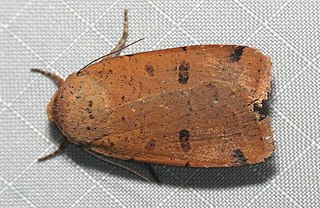
Abagrotis cupida, the Cupid dart or brown climbing cutworm, is a moth of the family Noctuidae. The species was first described by Augustus Radcliffe Grote in 1865. It is found in southern Canada and in the United States east of the Rocky Mountains.
Abagrotis orbis, the well-marked cutworm or Barnes' climbing cutworm, is a moth of the family Noctuidae. The species was first described by Augustus Radcliffe Grote in 1876. It is in southwestern North America, extending eastward across the plains and with a large disjunct population in dune habitats in the southern Great Lakes area. It extends into western Canada only in the southern interior of British Columbia and southern Alberta and Saskatchewan.

Acronicta sperata, the hopeful dagger moth, is a moth of the family Noctuidae. The species was first described by Augustus Radcliffe Grote in 1873. It is found in North America from New Brunswick west to the Alberta foothills, south to the District of Columbia, Missouri and in the mountains to Colorado.

Euxoa catenula is a species of moth of the family Noctuidae first described by Augustus Radcliffe Grote in 1879. It is found in North America from southern Saskatchewan west to southern Vancouver Island, south to Kansas, New Mexico, Arizona and southern California.

Euxoa mimallonis is a species of moth of the family Noctuidae first described by Smith in 1890. It is found in North America from Nova Scotia west to coastal British Columbia, south in the east to Michigan and Minnesota, in the west to central California and New Mexico.

Schinia nuchalis, the spotted sage moth, is a moth of the family Noctuidae. The species was first described by Augustus Radcliffe Grote in 1878. It is found from the Great Plains and Great Basin, from southern Saskatchewan, Alberta and British Columbia south to northern Arizona. The Eurasian Schinia scutosa is no longer considered a synonym of Schinia nuchalis.
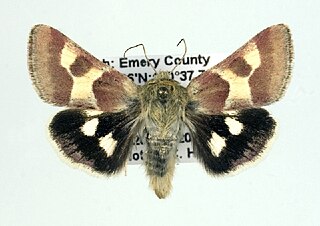
Schinia suetus is a moth of the family Noctuidae first described by Augustus Radcliffe Grote in 1873. It is widespread in the mountains of western North America, from southern Alberta west to British Columbia, south at least to Colorado and California, east to Idaho and New Mexico.
Photedes defecta, the narrow-winged borer, is a moth of the family Noctuidae. The species was first described by Augustus Radcliffe Grote in 1874. It is found in North America from Maryland and Massachusetts north to New Brunswick, west to North Dakota and British Columbia.
Euxoa campestris, the flat dart, is a moth of the family Noctuidae. The species was first described by Augustus Radcliffe Grote in 1875. It is found in North America from Newfoundland to Alaska, south to New England and southern Canada from southern Quebec west to British Columbia. In the west it is distributed southward in the Rocky Mountains to southern New Mexico, east-central Arizona, and central Utah. In the east it occurs in the Appalachians in eastern Kentucky and in western North Carolina.
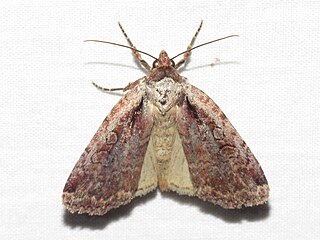
Eueretagrotis attentus, the attentive dart or daggered heath dart, is a species of moth in the family Noctuidae. It is found in North America from Nova Scotia to Saskatchewan and adjacent northern states, south in the Appalachians to Great Smoky Mountains National Park. There is one record from northern Georgia.
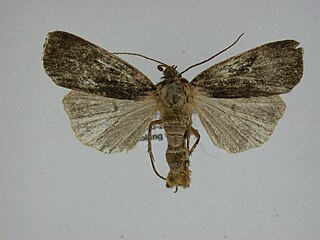
Pseudohermonassa bicarnea, the pink-spotted dart, is a moth of the family Noctuidae. The species was first described by Achille Guenée in 1852. It is found in eastern North America, and as far west as south-central Saskatchewan and central North Dakota, south to western North Carolina. It has recently been recorded from Tennessee.
Xestia normaniana, or Norman's dart, is a moth of the family Noctuidae. The species was first described by Augustus Radcliffe Grote in 1874. It is found in North America from Nova Scotia across southern and central Canada to Alberta. In the eastern United States it ranges from Maine to eastern Minnesota, and south along the Appalachians to western North Carolina. It has recently been recorded from Tennessee.
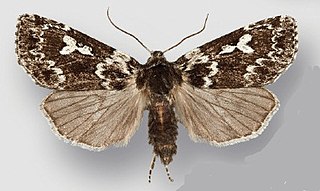
Xestia perquiritata, the boomerang dart, is a moth of the family Noctuidae. The species was first described by Herbert Knowles Morrison in 1874. It is found across North America from Newfoundland, Labrador and northern New England, west to central Yukon, British Columbia and Washington. There are several disjunct populations, including one in the Great Smoky Mountains National Park and the Rocky Mountains in Colorado and a coastal bog in central Oregon.
Coenophila opacifrons, the blueberry dart or plain-faced blueberry dart, is a moth of the family Noctuidae. The species was first described by Augustus Radcliffe Grote in 1878. It is found in North America from Labrador and Newfoundland, south to New Jersey, west across the boreal forest to eastern British Columbia, south in the mountains to southern Montana.

Euxoa detersa, the rubbed dart, sandhill cutworm or sand cutworm, is a moth of the family Noctuidae. The species was first described by Francis Walker in 1856. It is found in North America from Newfoundland to North Carolina, west to Nebraska, north to Alberta and the Northwest Territories.

Euxoa citricolor is a moth of the family Noctuidae first described by Augustus Radcliffe Grote in 1880. It is found in North America from eastern South Dakota and western North Dakota, northwest to southern Alberta, west to western Washington and south and east to southern California, New Mexico and Colorado.

Trichordestra legitima, the striped garden caterpillar moth, is a moth of the family Noctuidae. The species was first described by Augustus Radcliffe Grote in 1864. It is found in eastern North America, from Newfoundland to Florida, west to Texas, north to Saskatchewan.

Leuconycta lepidula, the marbled-green leuconycta moth, marbled-green jaspidia or dark leuconycta, is a moth of the family Noctuidae. The species was first described by Augustus Radcliffe Grote in 1874. It is found in North America from Nova Scotia to North Carolina, west to Texas and north to Alberta.











